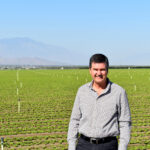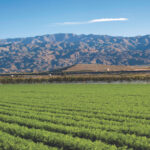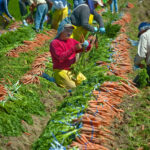The Coachella Valley in Southern California is home to farms that grow a wide variety of crops. Fruits, vegetables, citrus, and many others are produced in large numbers. One grower of this bounty is Peter Rabbit Farms, a third- and fourth-generation family farm that produces a plethora of crops, including one of the largest carrot crops in the United States. An evolution in the marketing, processing, and packaging of carrots has dramatically changed how they are grown as well as how consumers buy them. John Powell Jr. is a third-generation member of Peter Rabbit Farms, and he currently manages the farm with his brother.
Mr. Powell’s grandparents moved to the Coachella Valley in 1950 to take advantage of the new delivery of Colorado River water. Agriculture grew considerably during that time because farms could be irrigated with water that was delivered rather than drawn from wells. “My grandparents started out distributing produce for other farmers in the area before getting into farming themselves. Today, raising produce is our primary source of income, and carrots are the most common crop. We irrigate with Colorado River water and also incorporate as much water conservation technology as possible.” Mr. Powell added that the amount of carrots produced per acre has doubled in the past 20 years because of efficiency improvements in both land and water use.
Mr. Powell’s family has been involved with carrots since they first became a prominent crop in the Coachella Valley. “We decided to take advantage of our growing season, which is fairly short given the weather here. That makes it difficult to orchestrate a 12-month program. We became big growers of carrots in the 1990s, and we were the third-largest producer of cut and peeled baby carrots in the United States at that time. I first saw baby carrots around 1987 in grocery stores. At that time, my grandfather said they would be the future, and it now appears that he was right,” he said.
The most common form of carrots bought by consumers in grocery stores are cut and peeled baby carrots that come in bags, but that is a relatively new phenomenon. “What we call baby carrots are actually just cut and peeled carrots. Originally they were a byproduct of trying to use as much of the rest of the carrot as possible. Cutting, peeling, and shaping the parts of the carrot that were left over made them viable products. It became so viable that different varieties have been developed to make carrots more cylindrical in shape and more conducive to high-yield cut-andpeel techniques.” Mr. Powell said. He added that even the parts of the carrots left over after the cutting and peeling are useful, especially for juices. “There is very little waste now, which also leads to much higher production per acre. We are not only using more of what we grow, but we are also using new varieties to grow more per acre. This transition began 10–20 years ago, when we saw the large increases in production.”
Peter Rabbit Farms plants its carrots early in the year, beginning in August and continuing through December. Carrots are harvested from February through the end of May. Mr. Powell said the farm does not cut or process the carrots themselves; it works with another company in Bakersfield that specializes in doing so. The carrots are washed at the farm before being sent to the processing company, which cuts, processes, and bags them. Carrots are watered primarily with sprinkler irrigation. Mr. Powell said his family initially used furrow irrigation but has found that sprinklers offer better flexibility and control over the timing of the irrigations while also reducing water consumption.



Mr. Powell noted that farmers in the Coachella Valley recognize that they are always in drought conditions due to the low amount of rainfall they receive. “We consider it a precious supply. The farmers have invested a lot of money on their own in drip and microsprinkler technology to use water as efficiently as possible. We have district policies that assist with that, including prohibiting any tailwater or runoff from fields. The farmers are obligated to use that water for the crop and not let any be wasted. A lot of this technology was developed in the 1980s and has proliferated since then.”
Mr. Powell said Peter Rabbit Farms takes great pride in both its proud history and its bright future. “I am the third generation of our farm, and our own children are now coming into the business as well. We have always been in the same location since 1950, producing a nutritious, tasty crop that people love. We are also doing everything we can to be sustainable. Our objective is to continue operating in a way that will allow Peter Rabbit Farms to flourish for future generations, be part of the community, treat the land the way it should be treated, and manage our water resources so they will be available going forward.”

